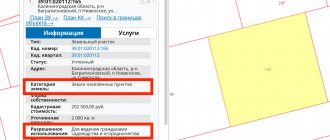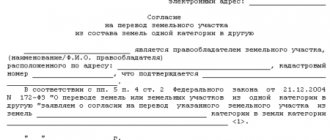The fate of the permit for a conditionally permitted type of use when changing the site/subject
Unlike the main types of permitted use, a conditionally permitted type of permitted use (URVI) can be selected only on the basis of a special decision on granting permission for the URVI, adopted by the authorized body (Article 39 of the Civil Code of the Russian Federation).
In practice, in most constituent entities of the Russian Federation it is stipulated that permission for an URVI is given for a certain period in compliance with the requirements for holding public hearings, but, as a rule, there is no other regulation.
At the same time, several questions arise that require solutions:
A) If the owner of a plot of land changes, does he need to obtain permission for the URVI again?
It follows from the law that permission for urban development is granted in relation to the site/ OKS without any connection to the copyright holder (Article 39, Civil Code of the Russian Federation). In this regard, it is logical to believe that a change of copyright holder should not affect the permit for URVI - its validity is limited only by the period, if such is established by regional legislation.
At the same time, it is objectively necessary to divide the situation into two periods:
— change of the copyright holder at the time of availability of permission for the URVI, but without changing the VRI in the Unified State Register of Real Estate to the URVI;
— change of the copyright holder at the moment when changes are made to the Unified State Register on the URVI on the basis of such permission.
In the first case, there is no direct regulation and conclusions can be drawn only on the basis of a systemic interpretation of the Civil Code of the Russian Federation about the absence of linking the permit for URVI to the subject.
In the second case, the URVI is already listed in the Unified State Register of Real Estate and on the basis of clause 4 of Article 85 of the Land Code of the Russian Federation, you can in any case continue to use the site with such an URVI. However, the issue with the validity of the URVI permit itself remains not directly regulated, and its validity is important for obtaining/non-receiving a construction permit.
B) If the site is modified (for example, divided), is it necessary to obtain a new permit for urban development?
In accordance with paragraph 3 of Art. 11.2 of the Land Code of the Russian Federation, the intended purpose and permitted use of the formed land plots are recognized as the intended purpose and permitted use of the original land plots from which they are formed.
In accordance with clause 51 of the Order of the Ministry of Economic Development of Russia dated December 8, 2015 No. 921, as well as Letter of the Ministry of Economic Development of Russia dated September 25, 2019 No. 13791-OG, the VRI of the formed land plots must correspond to the information of the Unified State Register of Real Estate on the VRI of the original land plot, with the exception of cases established by the legislation of the Russian Federation. Federation. Such cases include the selection of VRI from the main VRI provided for by the town planning regulations, as well as the choice of URVI in the presence of permission for URVI (a copy of such permission is included in the annex of the boundary plan).
Accordingly, from the above standards it follows that the VRI of the formed site must correspond to the VRI of the original site even if we are talking about an URVI, information about which is entered in relation to the formed site on the basis of a permit for the URVI obtained in relation to the original site.
The available judicial practice on the issue is small, but, in particular, the Appeal ruling of the Novosibirsk Regional Court dated June 11, 2013 in case No. 33-4462/2013 confirms the automatic transfer of the URVI to the newly formed land plots.
However, it should be noted that all of the above norms regulate the situation when the VRI in the Unified State Register has already been changed on the basis of a permit for an URVI, and the situation when there is a permit for an URVI, but the VRI has not been changed, remains unresolved.
Q) If permission for the URVI was received earlier by the GPZU, then is it necessary to obtain the GPZU again after receiving such permission?
Despite the fact that the list of Article 51 of the Civil Code of the Russian Federation on documents to be provided when issuing a construction permit does not mention a permit for a building permit, judicial and law enforcement practice has formed the position that the authorized body considers the grant/non-granting of a permit for a building permit as part of the project documentation (Definition Supreme Court of the Russian Federation dated October 15, 2019 No. 302-ES19-17845 in case No. A33-12034/2018, Resolution of the Arbitration Court of the Central District dated October 7, 2019 No. F10-3951/2019 in case No. A14-5533/2017, Resolution of the Arbitration Court of the East -Siberian District dated June 20, 2019 No. F02-1864/2019 in case No. A33-12034/2018).
At the same time, neither Article 57.3 of the Civil Code of the Russian Federation, nor the requirements for the content of the GPZU, approved by Order of the Ministry of Construction of the Russian Federation dated 04/25/2017 No. 741/pr, contain a requirement to indicate the presence of an issued permit for the URVI.
Thus, when obtaining a permit for an URVI after receiving a GPZU, it is not necessary to obtain a new GPZU, since it indicates all types of permitted use (both basic and conditionally permitted), and the purpose of issuance indicated in it does not limit the applicant in the construction of any facility , corresponding to the town planning regulations and VRI of the site.
D) If during the period of validity of the permit for the URVI, the type of permitted site was changed in Rosreestr to URVI, then after the expiration of the permit, is it possible to build a facility that complies with the URVI? Does the situation change if the construction of such a facility began before the expiration of the deadline, but ends after the expiration of such a period?
As stated earlier, when applying for a construction permit, the authorized body checks the availability of a building permit.
At the same time, both Article 51 and Article 55 of the Civil Code of the Russian Federation establish a rule that when issuing a construction permit, design decisions are checked for compliance with the permissible VRI on the date of issuance of the construction permit, and when issuing a permit for commissioning – on the date of issue of the commissioning permit.
In accordance with clause 4 of Article 85 of the Land Code of the Russian Federation, if the VRI does not comply with the urban planning regulations, the copyright holder has the right to continue its use as before without a time limit. But construction on the site cannot be attributed to “continued use”, since this is an obvious order and should be carried out only in accordance with the current town planning regulations. This means that it is impossible to start construction according to the URVI after the expiration of the permit for the URVI.
The situation changes if construction began before the expiration of the URVI, but ends after the expiration of such a period. Clause 5, clause 6, Article 55 of the Civil Code of the Russian Federation determines that the basis for refusal to issue a permit for commissioning is the non-compliance of the constructed facility with the permitted VRI of the site. Legal uncertainty arises: formally, the VRI of the site at the URVI was changed during the period of validity of the permit for the URVI and, therefore, the object corresponds to the “permitted VRI”. On the other hand, then the validity period of the URVI regulates the period when the owner can change the URVI in the Unified State Register, and not directly implement the URVI through construction on the corresponding site, which clearly contradicts the very idea of establishing such a period. Thus, we believe that in this case, commissioning is permissible and does not require renewal of the URVI permit.
General provisions on land use
Misuse of plots is prohibited by law. The permitted method is indicated in the documentation for the land: Cadastral passport and Certificate of ownership. If the land according to the papers is intended for residential development and subsidiary farming, industrial and administrative buildings cannot be built on it.
If the owner intends to change the nature of land use, to obtain permission it is necessary to contact the appropriate service and amend the allotment passport. If it is impossible to change the method of using the territory, you will have to sell the current one and purchase a new one.
The main document that guides government agencies in this regard is the urban planning plan - it indicates the goals and plans for the development of territories in a city or rural settlement. At the municipal level, rules for development and land use are established. They are based not only on the Land Code of the Russian Federation, but also on the economy and climate of the region.
They define:
- General directions of development of the region.
- Breakdown into zones (for residential construction, manufacturing, infrastructure, agriculture, etc.) with a description of the functionality and prohibitions for each.
- List of environmental protection measures.
- Borders of settlements.
Thanks to a clear division of the general territory into industrial, residential, administrative, agricultural, forest, environmental and other zones, it is possible to achieve order and the most rational use of land - conditionally permitted uses depend on them. The most commonly used functional zone is an area near a populated area.
Denial of conditionally permitted use
Reasons why changing the VRI of a land plot may be refused:
- There is self-development on the site.
- Objections were received during public hearings.
- The limit parameters for the requested purpose do not correspond to the area of the site.
- The site is leased by state or municipal authorities for a certain type of permitted use. By the way, the court’s position on this point is also the following: it is not allowed to change the purpose of land owned by public legal entities. It is believed that in this way tenants are trying to circumvent the bidding procedure.
There are other reasons for refusal, at the discretion of the local administration. The law does not contain a closed list of grounds for refusal. The authorized organization may justify a negative decision with any argument about the inappropriateness of such provision.
Types of permitted use of industrial land
| Name of the type of permitted use of the land* | Description of the type of permitted use of the land** | Code (numerical designation) of the type of permitted use of the land*** |
| 1 | 2 | 3 |
| Production activities | Placement of capital construction projects for the purpose of subsoil extraction, their processing, and industrial production of things. The content of this type of permitted use includes the content of types of permitted use with codes 6.1-6.9 | 6.0 |
| Subsoil use | Carrying out geological surveys; subsoil extraction by open (quarries, dumps) and closed (mines, wells) methods; placement of capital construction projects, including underground ones, for the purpose of subsoil extraction; placement of capital construction facilities necessary to prepare raw materials for transportation and (or) industrial processing; placement of capital construction projects intended for housing of employees performing maintenance of buildings and structures necessary for subsoil use purposes, if subsoil extraction takes place in an intersettlement area | 6.1 |
| Heavy industry | Placement of capital construction projects in the mining and processing and mining processing, metallurgical, mechanical engineering industries, as well as the manufacture and repair of automotive products, shipbuilding, aircraft manufacturing, mechanical engineering, machine tool manufacturing, as well as other similar industrial enterprises, for the operation of which the establishment of security or sanitary protection is provided zones, except in cases where the industrial facility is classified as another type of permitted use | 6.2 |
| Light industry | Placement of capital construction projects intended for the production of textiles, clothing, electrical (electronic), pharmaceutical, glass, ceramic and consumer goods | 6.3 |
| Food industry | Placement of food industry facilities for processing agricultural products in a way that leads to their processing into other products (canning, smoking, baking), including for the production of drinks, alcoholic beverages and tobacco products | 6.4 |
| Petrochemical industry | Placement of capital construction facilities intended for the processing of hydrocarbon raw materials, the production of fertilizers, polymers, chemical products for household use and similar products, as well as other similar industrial enterprises | 6.5 |
| Construction industry | Placement of capital construction facilities intended for the production of: building materials (bricks, lumber, cement, fastening materials), household and construction gas and plumbing equipment, elevators and lifts, carpentry products, prefabricated houses or parts thereof and similar products | 6.6 |
| Energy | Placement of hydropower facilities, nuclear power plants, nuclear installations (except for those created for scientific purposes), storage facilities for nuclear materials and radioactive substances, thermal stations and other power plants, location of service and auxiliary structures for power plants (ash dumps, hydraulic structures); placement of electric grid facilities, with the exception of energy facilities, the placement of which is provided for by the content of the type of permitted use with code 3.1 | 6.7 |
| Connection | Placement of communication facilities, radio broadcasting, television, including aerial radio relay, overhead and underground cable communication lines, radio lines, antenna fields, amplification points on cable communication lines, satellite communications and television and radio broadcasting infrastructure, with the exception of communication facilities, the placement of which is provided for by the content of the type of permitted use with code 3.1 | 6.8 |
| Warehouses | Placement of structures intended for temporary storage, distribution and transshipment of cargo (except for the storage of strategic reserves) that are not parts of the production complexes where the cargo was created: industrial bases, warehouses, loading terminals and docks, oil storage facilities and oil loading stations, gas storage facilities and gas condensate and gas pumping stations, elevators and food warehouses serving them, with the exception of railway transshipment warehouses | 6.9 |
| Providing space activities | Location of cosmodromes, launch complexes and launchers, command and measurement complexes, centers and flight control centers for space objects, points for receiving, storing and processing information, storage bases for space technology, landing sites for space objects, experimental base facilities for testing space technology, centers and equipment for training cosmonauts, other structures used in space activities | 6.10 |
| Transport | Placement of various types of communication routes and structures used for the transport of people or goods, or the transfer of substances. The content of this type of permitted use includes the content of types of permitted use with codes 7.1 -7.5 | 7.0 |
| Railway transport | Placement of railway tracks; placement of capital construction facilities necessary to ensure railway traffic, boarding and disembarking passengers and their related services, including railway stations, railway stations, loading docks and warehouses (with the exception of warehouses for fuel and lubricants and gas stations of any type, as well as warehouses intended for storage of hazardous substances and materials); placement of ground-based metro structures, including landing stations, ventilation shafts; placement of ground structures for tram service and other special roads (cable cars, monorails) | 7.1 |
| Automobile transport | Placement of roads outside the boundaries of a populated area; placement of capital construction facilities necessary to ensure road traffic, boarding and disembarking passengers and their related services, as well as facilities intended to accommodate posts of internal affairs bodies responsible for road safety; equipment of land plots for parking of motor vehicles, as well as for the placement of a depot (arrangement of parking areas) for motor transport transporting people along an established route | 7.2 |
| Water transport | Placement of inland waterways artificially created for navigation, location of sea and river ports, berths, piers, hydraulic structures, and other facilities necessary to ensure navigation and water transportation | 7.3 |
| Air Transport | Placement of airfields, helipads, arrangement of places for splashdown and mooring of seaplanes, placement of other facilities necessary for take-off and landing (splashdown) of aircraft, location of airports (air terminals) and other facilities necessary for boarding and disembarking passengers and their related services and support their safety | 7.4 |
| Pipeline transport | Placement of oil pipelines, water pipelines, gas pipelines and other pipelines, as well as other buildings and structures necessary for the operation of these pipelines | 7.5 |
| Ensuring defense and security | Placement of capital construction facilities necessary for the preparation and maintenance of combat readiness of the Armed Forces of the Russian Federation, other troops, military formations and their control bodies (location of military organizations, internal troops, institutions and other facilities, deployment of troops and naval forces), conducting military exercises and other activities aimed at ensuring the combat readiness of military units; placement of buildings of military schools, military institutes, military universities, military academies | 8.0 |
| Providing for the Armed Forces | Placement of capital construction projects intended for the development, testing, repair or destruction of weapons, military equipment and ammunition; development of land plots as testing grounds, places for the destruction of weapons and disposal of waste arising in connection with the use, production, repair or destruction of weapons or ammunition; placement of capital construction projects necessary for the creation and storage of inventories of material assets in the state and mobilization reserves (storage facilities, warehouses and other facilities); placement of objects to ensure the safety of which closed administrative-territorial entities were created | 8.1 |
| Protection of the State Border of the Russian Federation | Placement of engineering structures and barriers, border markers, communications and other objects necessary to ensure the protection and security of the State Border of the Russian Federation, arrangement of border clearings and control strips, placement of buildings for the deployment of border military units and their management bodies, as well as for the location of checkpoints across the State border of the Russian Federation | 8.2 |
| Ensuring internal law and order | Placement of capital construction facilities necessary for the preparation and maintenance of readiness of internal affairs bodies and rescue services in which there is a paramilitary service; placement of civil defense facilities, with the exception of civil defense facilities that are parts of industrial buildings | 8.3 |
| Ensuring activities for the execution of punishments | Placement of capital construction projects for the creation of places of deprivation of liberty (pretrial detention centers, prisons, settlements) | 8.4 |
The cost of services for changing the type of permitted use is from 60,000 rubles. The cost of services for changing the category of a site (if there is a project) is from 200,000 rubles.
Change of copyright holder and URVI
The legislation applies rules for changing ownership when the intended purpose of the plot is documented:
- Since the URVI is tied to the property, it does not change when the owner changes.
- The type of use changes if, upon transfer of ownership rights, its validity period expires.
- Simultaneously with the transfer of ownership, an application to change the ID can be submitted.
When dividing one plot into several, the conditionally permitted type of use of the land does not change.
Consolidation of several plots and VRI
You can merge areas that have at least one border. By law they are recognized as adjacent. Conditions under which merger is permitted:
- Consent of all owners.
- Each plot has a cadastral passport (you must take an extract from the Unified State Register of Real Estate).
- The same type of permitted use (indicated in the USRN extract).
- Same land category.
- The plots correspond to the maximum minimum and maximum indicators in a given location area.
If the VRI of the plots are different and the goal is to combine them, you can try to apply to change the type of operation of one of the plots. In order to combine territories, you must contact a cadastral engineer with a previously collected package of documents. He will draw up a plan, which, along with the application, the owners submit to the Rosreestr institution or the Multifunctional Center.
Grounds and procedure for assigning VRI
The procedure for obtaining a permit is multi-stage and is carried out in accordance with the provisions of Art. 39, art. 5.1 Town Planning Code of the Russian Federation.
Submitting an application
An organization or citizen must first contact the commission operating in each municipality that considers issues regarding the rules of development and land use. Usually the application is accompanied by documents and justifications that describe all the advantages of the possible use of the site according to the conditionally permitted use.
Organizing and conducting public or public hearings
Based on the application received, the commission organizes open hearings , access to which is allowed to all persons. The commission publishes information in the media about the date and time, location of the hearing (determined by the commission), and also indicates in the announcement information about the person requesting permission, about the land plot, and about the requested type of use.
In addition, messages about upcoming hearings are sent via mail to the owners of all adjacent land plots.
At the hearing, after the applicant and members of the commission have given the floor on the issue under discussion, a conversation is held with the population. Citizens and representatives of organizations can express their opinions and make recommendations regarding the granting of rights.
The hearings end with a vote, and based on its results, a conclusion is drawn up with two possible decisions:
- recommend granting the applicant the right to a conditionally permitted use;
- do not recommend granting the applicant the right to conditionally permitted use.
Conclusions on the results of the public discussion are published in the media.
Important! The deadline for this procedure is set: one month, calculated from the date of publication of the notice of the hearings until the date of publication of the conclusion on their results.
Preparation of recommendations by the commission
The results of the public discussion are discussed at a meeting of the commission, but the applicant is not allowed to attend this meeting. The commission also forms its recommendations and makes a conclusion about the advisability or impossibility of granting permission.
After this, all materials (findings of the hearings, recommendations of the commission) are sent to the head of the municipality for consideration and making a final decision.
Didn't find the answer to your question? Check out other articles on similar topics:
- VRI for private household plots.
- Changing the type of permitted use of memory.
- By whom and how is VRI installed?
- What are the differences and which is better:
- Peasant farms and private household plots.
- Private household plots and individual housing construction.
- SNT and individual housing construction.
Where are URVI indicated?
The main document of the municipality regulating urban development within its boundaries is the Land Use and Development Rules. Therefore, for construction on a specific site, it is necessary to familiarize yourself with them in advance in order to avoid unpleasant situations later.
Often such rules are called a “land construction passport”, which contains information about the allotment. They include all permissible types of its use (including conditionally permitted), as well as restrictions on the land. There is also a topographical diagram with construction zones, red lines, etc.
An urban development plan is issued to the land owner only on the basis of an application submitted to the local government body. Preparation takes 20 working days, calculated from the date of application, and is issued free of charge (Article 57 3 of the Town Planning Code).
VRI classifier
In 2014, in order to unify documentation on territory planning throughout Russia, a Unified Classifier of Types of Use of Land Plots was approved. It contains common language for all VRIs, which will be used in all municipalities after the transition period.
Previously, such a classifier did not exist; local authorities independently formulated acceptable VRI, which led to both inconsistency between different cities and many problems in interpreting the content of VRI. This became an obstacle in obtaining construction permits for some developers.
However, the classification of a specific VRI as a main, conditionally permitted, auxiliary type within the zones still remains within the exclusive competence of local authorities. You can get acquainted with the full list of VRI by referring to the order of the Ministry of Economic Development of the Russian Federation dated September 1, 2014 No. 540.
Zones
The conditionally permitted use of a land plot can be any from a possible list. Moreover, depending on the functionality of the zone and the decision of the authorities, one territory may have one list of types of uses, and another - different from it.
Conditionally permitted for residential sectors in terms of land development will be the construction within their boundaries of free-standing buildings:
- for retail spaces, shopping and entertainment centers;
- Catering;
- office and administrative;
- medical, etc.
In the area designated for business and public use, residential buildings of a private and multi-apartment nature are classified as conditionally permitted uses. For production zones, all of the listed species will become conditionally permitted.
Zoning of the territory from the point of view of urban planning is carried out in accordance with the fourth chapter of the Civil Code. The Code establishes the need for the development and approval by the head of the territorial administration of Land Use and Development Rules, including:
- general provisions (the procedure for their application and amendments);
- zoning map for possible development purposes;
- town planning regulations.
The draft Rules are required for public discussion. After approval at all stages, they are approved by the head of local government. Changes can be made at the initiative of an interested party (for example, when planning a development). But this requires coordination with the competent structures, passing the stage of public hearings and approval by the municipal authority.









